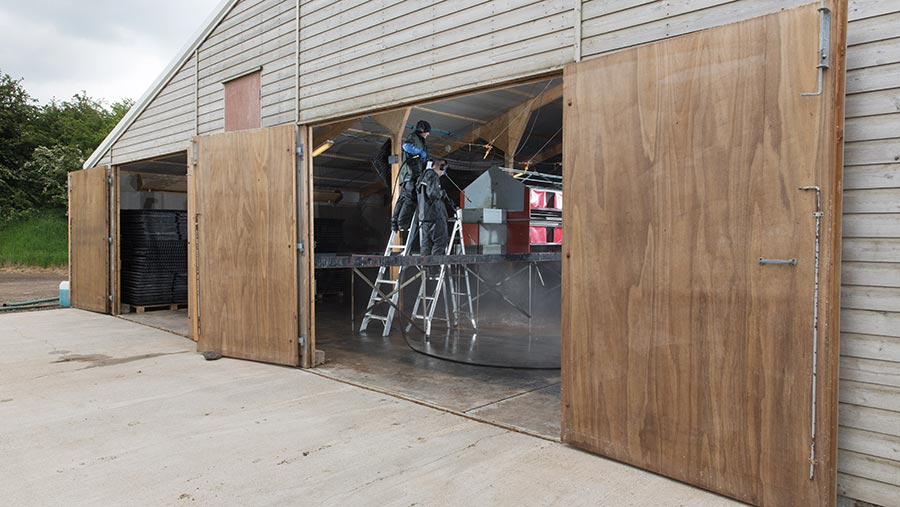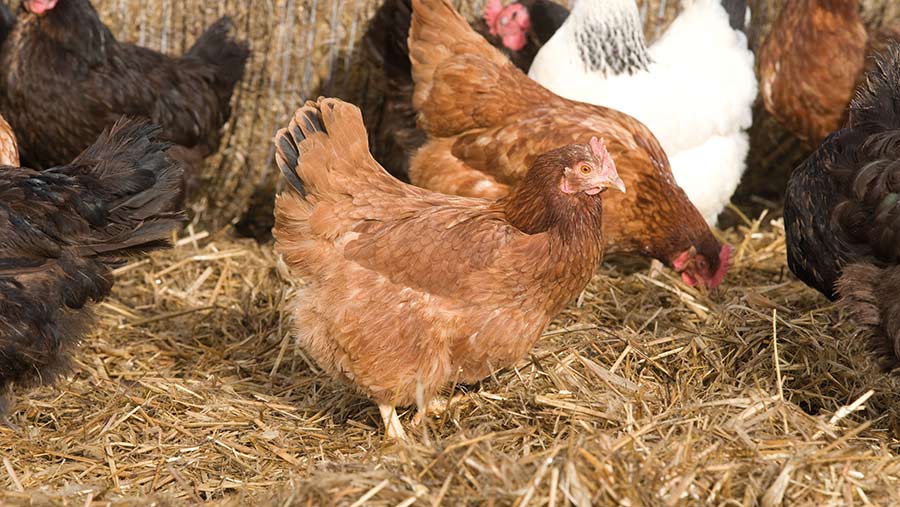Advice on identifying, treating and preventing red mite
 © Tim Scrivener
© Tim Scrivener Up to 90% of all UK commercial poultry units are affected by red mite, and it can cause devastating losses if left unchecked.
That is why identifying and treating issues promptly will deliver the best return on investment.
“Red mite is the most economically significant ectoparasite in commercial poultry production,” explains Matthew Balfour, regional lead vet at St David’s Poultry Team.
“However, we do have good tools in our arsenal that represent an excellent return on investment, if used strategically.”
See also: A poultry producer’s guide to red mite control
How to identify a problem
Red mite (Dermanyssus gallinae) is almost impossible to eliminate once a site is affected, which makes regular monitoring vital.
Mr Balfour recommends deploying traps strategically throughout a shed and, as soon as mites are found, producers should consult their vet about management and treatment options.
“We want to keep mite levels low throughout the lifetime of the flock, not give them the opportunity to build up to high levels, which will compromise bird welfare and egg production.”
Other signs of infestation include behavioural changes, he adds. “Birds may become restless, and the shed could be noisier.”
Feather pecking – and therefore feather loss – may also increase, potentially leading to cannibalism.
Given the recent Defra housing measures in England to tackle avian influenza, all producers should remain vigilant.
With more birds housed and popholes closed, house temperatures will rise, which favours the mite and could result in a sharp increase of parasite numbers.
The red mite lifecycle
The parasite’s lifecycle is rapid, especially in optimal conditions. Eggs develop into mature mites in just seven days, so populations can explode almost overnight.
- Eggs hatch after two to three days and the six-legged larvae emerge
- One to two days later they moult into eight-legged nymphs and begin to feed on the birds’ blood at night
- Three days on, and the mites can be considered mature
- Within one to two days the females will mate and lay eggs; the cycle repeats and the infestation rate rises.
What is the impact on productivity?
“The unit will see a drop in production as the birds become bothered at night; they’re irritated and bitten and are constantly stressed,” says Mr Balfour.
You will quite often see a rise in mortality, he adds. “Birds that were previously tolerant to environmental pathogens like E coli can become more susceptible to opportunistic infection as mites move from bird to bird.”
Mites can also propagate diseases such as salmonella, pasteurella and erysipelas. Where pathogenic E coli exists, even a well-controlled red mite population is likely to see mortality of 2-3% by 72 weeks.
A poorly managed infestation could see mortality exceeding 5% over the same period.
Feed conversion ratio and egg formation can be negatively affected, too. Birds with feather loss will need to eat more to stay warm. This saps energy that could otherwise be used for production.
As the mites are active overnight, the stress will affect egg formation, leading to poorer grading and payments.
Given these knock-on effects, a 2017 Dutch study estimated that an average infestation level equated to a loss of 52p a bird. Soaring feed costs mean that figure will be much higher now.
Treatment options
Treatments are changing – vaccines are in development but are still some way off commercial viability. And with insecticide resistance continuing to be an issue, standalone treatment options are limited, says Mr Balfour.
“Fortunately, new fluralaner (carbamoyl-benzamide-phenyl-isoxazoline) products like Exzolt will eliminate over 99% of mites if used properly, with correctly calculated bird bodyweights being absolutely vital,” he says.
Fluralaner is a prescription in-water treatment that is usually delivered in two initial doses given a week apart, providing cover for about 12 weeks.
Within 12 hours of the birds drinking, mature mites that feed from the hens are killed.
The second treatment is necessary as it coincides with the maturation of the parasite, helping to break the cycle and significantly reduce mite numbers.
“In an advanced outbreak you can expect to see a swift improvement in production post-treatment,” he explains.
“Mortality will also be quickly improved. In a recent case of E coli-related peritonitis, mortality dropped by one-third after treatment due to removing mite bite transmission.”
Fluralaner is a big breakthrough when it comes to return on investment, says Mr Balfour.
“It achieves a much better kill rate compared with insecticides, so producers can expect a more significant bounce back in production levels.
“Furthermore, administration costs in terms of labour are reduced, and health and safety for staff is improved.” However, it is important to adopt a holistic approach, he says.
“There is no one answer to red mite. A rotation of in-water treatments, sprays and dusts, good biosecurity measures, as well as a considered cleaning and disinfection protocol, is how we prevent reduced productivity and achieve the best return on investment.”
Biosecurity and prevention
Cleaning and disinfectant protocols at turnaround are critical in the battle against red mite.
Producers should first remove all organic matter and perform a wet clean with detergent, as dry cleans are not effective in red mite control.
The shed must then be left to dry thoroughly before disinfecting.
“Applying disinfectant to a wet surface can increase your dilution rate quite substantially,” warns Mr Balfour. “If your dilution rate is not correct, then it is not going to kill mite eggs.”
Selecting the right disinfectant is also important; Interkokask is Mr Balfour’s preferred choice due to its efficacy against red mite eggs, although there are other products on the market.
Biosecurity to prevent transmission between flocks is vital, including a barrier system and changing footwear and overalls between sheds.
Wild birds can spread red mite, so it is important to keep them away from ranges where possible and ensure sheds are in a good state of repair.
Pullets can be another source of transmission. Reputable suppliers will be careful to ensure birds are mite-free, but farmers should visually inspect pullets for mites on arrival and have an open dialogue with suppliers about treatments and monitoring.
“Red mite will be an ongoing challenge for the industry,” admits Mr Balfour. “But we now have a selection of good tools to control them.
“Unfortunately, a limiting factor is producers’ lack of appreciation of the economic impacts of red mite, especially when considering the secondary effects.
“But if we can use those tools correctly and strategically, the economic value of addressing this issue is clear.”
Organic systems

© Tim Scrivener
Treating red mite can be more difficult within organic systems as producers are very limited in their use of sprays.
“Due to extended withdrawal periods, fluralaner-based treatments are considered less economically viable by organic farmers,” says Mr Balfour.
“Potentially, organic systems can look to a biological solution like predator mites for control, but a moderate to heavy infestation is required to initially support the predator mite population.
Also, site-specific factors can reduce the efficacy.”
Mr Balfour recommends diatomaceous earth products for treatment, but producers should check what products are approved by their certification body.
